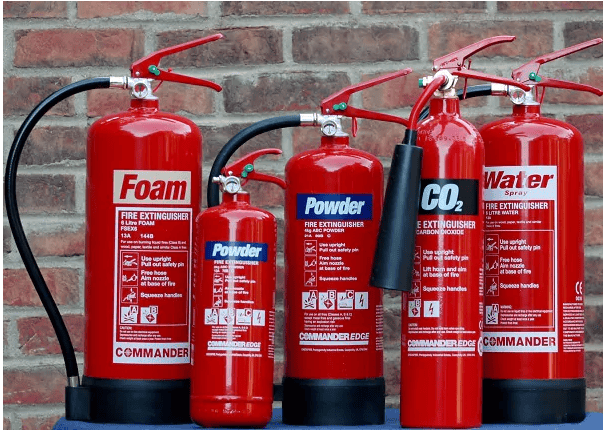There are numerous strategies for mitigating fire risks in commercial buildings. For example, property owners can install a variety of fire extinguishers in their buildings. They can also elect to have fire suppression systems or sprinklers installed as well. Note that there are significant differences between all three of these solutions.
While we may use terms like ‘fire extinguishers’ and ‘fire suppression systems’ interchangeably, they really aren’t the same thing. Understanding the differences is important when you are trying to determine the best design for a given property. There are situations in which only one solution is necessary. Other situations dictate deploying multiple solutions simultaneously.
Fire Extinguisher Basics
Finding fire extinguishers in businesses is fairly routine. As a general rule, fire extinguishers are recognised as hand-held devices for combating active fires. There are multiple kinds of fire extinguishers that deploy everything from water to foam to powder. The choice of a firefighting agent is dependent on what is fuelling the fire.
A fire extinguisher that expels only water would work just fine for a fire being fuelled by paper, wood, etc. It would be useless in a petroleum fuelled fire. In fact, spraying water on a petroleum fire only serves to spread the fire. As such, you are looking at a foam or powder-based fire extinguisher to stop that fire.
The key take-away here is that fire extinguishers are hand-held devices. They are also portable. They can be deployed in a variety of locations around a building and, if necessary, transported from one location to another. They must also be manually recharged and inspected on a regular basis.
Fire Suppression Systems
While you could make the case that a fire extinguisher is a fire suppression device, fire suppression systems are generally acknowledged as being built-in systems with a much wider area of coverage. While a single fire extinguisher is limited in its coverage, a fire suppression system can cover an entire building. They can also be active or passive.
Your typical fire suppression system is installed when a building is first constructed. The only evidence of such a system might be the heads protruding from the ceiling. Yet behind ceilings and walls is a maze of pipes and valves that all work together to deliver fire suppression materials in the event the system is activated. All of the plumbing generally leads back to a central location from where fire suppression agents are sourced.
Having said all that, there is a significant difference between a fire suppression system and a sprinkler system. Fire suppression systems are unique in that they do not deploy water to combat fires. Instead, they deploy chemical agents in the form of either foam or powder.
Again, the type of agents deployed depends on the kind of fire being addressed. It is impractical to equip a typical fire suppression system with multiple agents, so architects and engineers generally choose a primary agent based on the most likely scenario for that given space.
Sprinkler Systems
The most basic of all firefighting systems is the sprinkler system. It is installed throughout a building during the earliest phases of construction, alongside plumbing. Sprinkler systems can also be installed after the fact. They are fairly simple to design and rather effective for their task.
Unlike a fire suppression system, sprinklers only deploy water in the event of activation. Water smothers an active fire by denying it oxygen. It also cools the fire so as to lower its combustion temperature, thereby preventing the fire from spreading. It is all pretty basic from a chemistry standpoint.
Sprinkler systems are commonly found in commercial buildings where flammable liquids and gasses are not normally present. For example, you wouldn’t expect to find highly combustible petroleum products stored in a medical office. Sprinkler systems are ideal for medical environments because they are cost-effective, easy to install, and suitable for the kinds of fires most likely to occur in such environments.
Designing Firefighting Solutions
Within these three primary methods of fighting fires, there are dozens of ways to design a firefighting solution. For example, there are four different types of sprinkler systems: wet pipe, dry pipe, pre-action, and deluge sprinklers. Each has its particular uses.
Designing a firefighting solution starts with analysing the types of fires most likely to occur in a given space. Fires are divided into six distinct classes:
- Class A – Fuelled by dry substances like wood and paper
- Class B – Fuelled by flammable liquids including petroleum and solvents
- Class C – Fuelled by flammable gases like butane and propane
- Class D – Fuelled by metals like potassium and aluminium
- Class F – Cooking fires
- Electrical fires – (note that the Class E designation is no longer used).
Finally, firefighting solutions have to be designed with coverage in mind. How big is the space in question? How quickly could fire spread from that space to another? These considerations, and more, often dictate whether or not hand-held fire extinguishers are appropriate.
Fire extinguishers, fire suppression systems, and sprinklers all serve a common purpose. Yet they are different in many ways. Understanding the differences is key to designing an effective firefighting solution.


